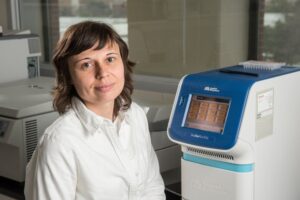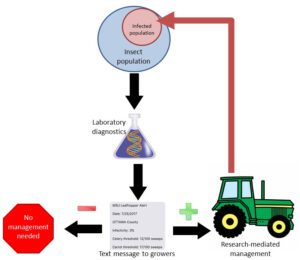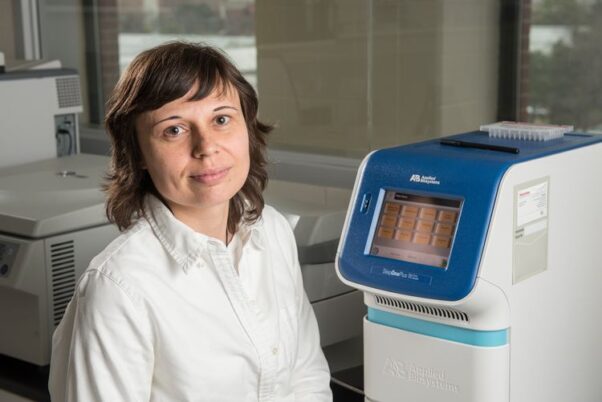Mar 31, 2023MSU lab helps protect Michigan’s vegetable crops
Vegetable growers in Michigan have long sought a more rapid and efficient method to screen for the damaging plant disease, aster yellows.
Primarily affecting carrots and celery in Michigan, aster yellows causes plants to have stunted or deformed growth, distorted or discolored foliage and a bitter taste, rendering infected plants unmarketable.
Nearly a decade ago, in stepped Michigan State University associate professor and vegetable entomologist Zsofia Szendrei to address disease response. Szendrei’s research, teaching and outreach center around the ecology and management of arthropods that occur in vegetable production. One such arthropod, the aster leafhopper, carries the pathogen causing aster yellows.


Szendrei has employed a laboratory procedure using a molecular biology technology called polymerase chain reaction – which amplifies samples of genetic code, allowing researchers to analyze it more clearly. It tests leafhopper specimens to estimate the percentage of aster yellows infected insects in any given field. Funding for Szendrei’s research came from MSU Project GREEEN, MSU AgBioResearch, the Michigan Vegetable Council and the Michigan Department of Agriculture and Rural Development (MDARD).
“The original protocols for aster yellows screening sometimes took days to get results. Growers can’t afford to spend that much time waiting to know if they need to spray, so we had to come up with a better solution for them,” Szendrei said.
Szendrei’s lab partnered with the Michigan Celery Promotion Cooperative, Michigan Carrot Committee, and MSU Extension to build a diagnostic network for the screening of aster leafhopper infestations.
Growers, field managers, scouts, or MSU Extension specialists conduct periodic sweeps of vegetable crops around the state to collect leafhopper specimens that are then brought to the lab. In as little as 24 hours, Szendrei can send a group-text to the growers with the results.
“The growers have really embraced this program,” Szendrei said. “Having this technology at their service and being able to receive accurate data in real-time has made a big difference in their fields.”
Michigan’s carrot and celery growers are integral to the state’s agricultural economy, which prides itself on its variety of commodities as the second most agriculturally diverse state in the U.S. Michigan’s carrot growers produce approximately 150 million pounds of carrots, worth $15 million per year. The celery industry generates approximately $19 million annually from 110 million pounds grown. The state ranks fourth nationally for carrot production and second nationally for celery.


“Michigan agriculture would not be what it is without the success of our vegetable growers and the support they receive from researchers at MSU,” said Jamie Clover Adams, executive director of the Michigan Carrot Committee, Michigan Asparagus Committee and former director of the Michigan Department of Agriculture and Rural Development. “If our growers didn’t have the information and resources provided by Zsofia and the other vegetable researchers at MSU to combat disease and the various other issues vegetable crops face, our growers might not be growing carrots. Having resources at MSU to support the wide variety of our growers is important for the state’s economy and the economy of a lot of communities where these crops are grown and processed.”
Partnerships on the farm
Ralph Oomen and his son, Tyler, own and operate Oomen Veggie Co. in Oceana County, a 1,800-acre farm with a diverse crop rotation that includes carrots among various other vegetables. Oomen has been farming since 1983 and has partnered with MSU on research and outreach projects for nearly as long.
“We have been cooperating with MSU researchers for as long as I can remember. No research means no future is the way I see it,” Ralph Oomen said. “For a vegetable-crop farm or specialty-crop farm no one does your research unless you get someone from the university’s attention to help you out, and we’ve been very fortunate that MSU has worked with us. We partner with them to host research and share results and we use the information from them to guide our management. It’s been a pretty good partnership over the years.”


Only approximately 5% of aster leafhoppers carry the aster yellows pathogen, but even small outbreaks have resulted in significant yield reduction, averaging 25% in carrots and occasionally rising as high as 80%.
The only effective means of preventing the spread of aster yellows is to reduce the leafhopper population through pesticide applications. To do this, growers need a rapid and accurate estimate of the number of leafhoppers in their fields and also the number of those infected with the aster yellows phytoplasma.
“In the old days, we had a threshold of say, 15 aster leafhoppers per 100 sweeps. If you hit that number, you sprayed. Over the years, we started to test aster leafhoppers for aster yellows, but the test wouldn’t come back for a number of days and by that time you’ve already had to spray your fields,” Oomen said. “Zsofia took that original research and developed her method, which can tell us what infectious rate the leafhopper has within 24 hours or so. Now we know whether we have to spray in real-time, because we can change our threshold compared to how infected the leafhopper is now.”
To read the full article, click here.
– Justin Whitmore, MSU AgBioResearch communications and marketing















